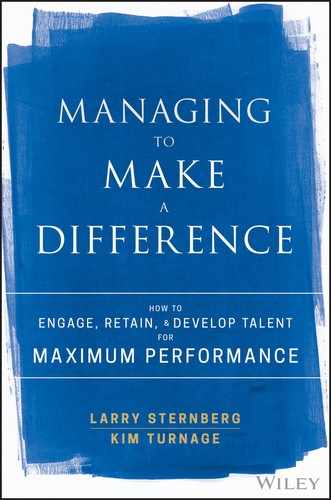Chapter 65
Take Action on Legacy Employees
In times of change, managers have to deal with legacy employees. Many of these people have been loyal, hard-working, and good ambassadors for your company. But your business is changing in ways that are not favorable to some of them. These employees helped you get to where you are now, and you truly appreciate their contributions. It is not their fault, but some of these people are no longer a good fit for the company. What do you do?
This is a common situation. It is difficult for everyone involved. As a manager, you must balance the needs of multiple stakeholders:
- One employee, or a few, who have been loyal to your organization
- Other employees who are making the shift more successfully
- Your organization's clients, customers, guests, or patients
- The people whose interests you ultimately serve—shareholders, taxpayers, donors, owners, and so forth
All the potential solutions we offer here have painful side effects. What are your alternatives? We suggest you start here:
- Allow them to continue in their current role, giving them the opportunity to meet the current expectations for the role.
This is the most attractive option for us, and it is the best place to start. Expectations have evolved with changes in the business and some of your employees are not evolving at the same rate. Clarify the new performance expectations. Give them all the support and help you reasonably can. But hold them accountable. This alternative demonstrates strong loyalty to individuals who are struggling with change, without compromising your duty to other stakeholders or your ability to maximize organizational performance. We recommend you try this alternative first. Then, if they cannot meet the expectations, revert to one of the other options listed here.
- Recast them into another job.
This could require them to take a pay cut, or you could decide to grandfather their compensation. Either way, at least they still have a job. This alternative demonstrates a balance between loyalty to these individuals and your duty to maximize benefits to stakeholders.
- Terminate their employment, with severance and help.
Unfortunately, recasting is often impossible, either for the organization or for the person. You could give the person a generous severance package, and you could extend yourself to help him or her find another job. This shows some loyalty and empathy for the employee, while emphasizing benefits to stakeholders.
- Terminate their employment without severance or help.
We think this is an undesirable way to go. It maximizes benefits to stakeholders, but it demonstrates no loyalty at all. Your employees will get the message. You expect loyalty, but you do not reciprocate. If you choose this option, do not state that loyalty is a core value that defines your culture. This, at least, allows you to avoid hypocrisy.
- Carry them. Allow them to continue in their present role, even though they cannot meet the current expectations for the role.
This can be an attractive option at first glance. Perhaps some of these people are close to retirement. You could demonstrate outstanding loyalty by carrying them and simply tolerating their deficiencies. However, this alternative requires extra investment to compensate for these deficiencies, and does not maximize benefits to stakeholders—especially other employees who will likely be doing most of the carrying. This kind of tolerance for poor performance does not enhance your image as a manager. Do not choose this option for people who are not very close to retirement. Even for people who are nearing retirement, the recasting and severance with help options discussed in this chapter are better.
